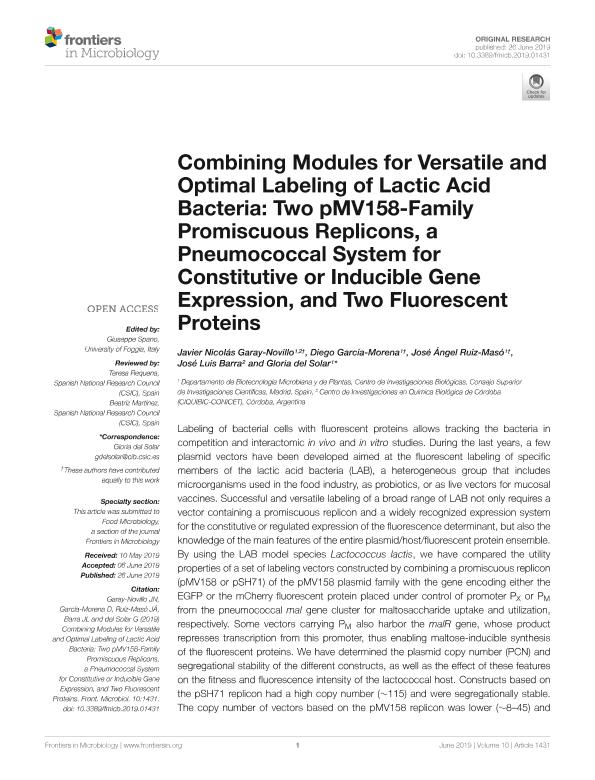Mostrar el registro sencillo del ítem
dc.contributor.author
Garay Novillo, Javier Nicolás

dc.contributor.author
García-Morena, Diego
dc.contributor.author
Ruiz-Masó, José Ángel
dc.contributor.author
Barra, Jose Luis

dc.contributor.author
del Solar, Gloria
dc.date.available
2021-03-17T15:09:58Z
dc.date.issued
2019-06
dc.identifier.citation
Garay Novillo, Javier Nicolás; García-Morena, Diego; Ruiz-Masó, José Ángel; Barra, Jose Luis; del Solar, Gloria; Combining modules for versatile and optimal labeling of lactic acid bacteria: Two pMV158-family promiscuous replicons, a pneumococcal system for constitutive or inducible gene expression, and two fluorescent proteins; Frontiers Media S.A.; Frontiers in Microbiology; 10; 6-2019; 1-22
dc.identifier.uri
http://hdl.handle.net/11336/128460
dc.description.abstract
Labeling of bacterial cells with fluorescent proteins allows tracking the bacteria in competition and interactomic in vivo and in vitro studies. During the last years, a few plasmid vectors have been developed aimed at the fluorescent labeling of specific members of the lactic acid bacteria (LAB), a heterogeneous group that includes microorganisms used in the food industry, as probiotics, or as live vectors for mucosal vaccines. Successful and versatile labeling of a broad range of LAB not only requires a vector containing a promiscuous replicon and a widely recognized expression system for the constitutive or regulated expression of the fluorescence determinant, but also the knowledge of the main features of the entire plasmid/host/fluorescent protein ensemble. By using the LAB model species Lactococcus lactis, we have compared the utility properties of a set of labeling vectors constructed by combining a promiscuous replicon (pMV158 or pSH71) of the pMV158 plasmid family with the gene encoding either the EGFP or the mCherry fluorescent protein placed under control of promoter PX or PM from the pneumococcal mal gene cluster for maltosaccharide uptake and utilization, respectively. Some vectors carrying PM also harbor the malR gene, whose product represses transcription from this promoter, thus enabling maltose-inducible synthesis of the fluorescent proteins. We have determined the plasmid copy number (PCN) and segregational stability of the different constructs, as well as the effect of these features on the fitness and fluorescence intensity of the lactococcal host. Constructs based on the pSH71 replicon had a high copy number (~115) and were segregationally stable. The copy number of vectors based on the pMV158 replicon was lower (~8-45) and varied substantially depending on the genetic context of the plasmid and on the bacterial growth conditions; as a consequence, inheritance of these vectors was less stable. Synthesis of the fluorescent proteins encoded by these plasmids did not significantly decrease the host fitness. By employing inducible expression vectors, the fluorescent proteins were shown to be very stable in this bacterium. Importantly, conditions for accurate quantification of the emitted fluorescence were established based on the maturation times of the fluorescent proteins.
dc.format
application/pdf
dc.language.iso
eng
dc.publisher
Frontiers Media S.A.
dc.rights
info:eu-repo/semantics/openAccess
dc.rights.uri
https://creativecommons.org/licenses/by-nc-sa/2.5/ar/
dc.subject
FLUORESCENT LABELING VECTORS
dc.subject
FLUORESCENT PROTEIN MATURATION
dc.subject
FLUORESCENT PROTEIN STABILITY
dc.subject
LACTIC ACID BACTERIA
dc.subject
MCHERRY AND EGFP
dc.subject
PLASMID COPY NUMBER
dc.subject
PLASMID FITNESS COST
dc.subject
PLASMID STABILITY
dc.subject.classification
Biología Celular, Microbiología

dc.subject.classification
Ciencias Biológicas

dc.subject.classification
CIENCIAS NATURALES Y EXACTAS

dc.title
Combining modules for versatile and optimal labeling of lactic acid bacteria: Two pMV158-family promiscuous replicons, a pneumococcal system for constitutive or inducible gene expression, and two fluorescent proteins
dc.type
info:eu-repo/semantics/article
dc.type
info:ar-repo/semantics/artículo
dc.type
info:eu-repo/semantics/publishedVersion
dc.date.updated
2020-11-20T20:00:38Z
dc.identifier.eissn
1664-302X
dc.journal.volume
10
dc.journal.pagination
1-22
dc.journal.pais
Suiza

dc.journal.ciudad
Lausana
dc.description.fil
Fil: Garay Novillo, Javier Nicolás. Consejo Superior de Investigaciones Científicas; España. Consejo Nacional de Investigaciones Científicas y Técnicas. Centro Científico Tecnológico Conicet - Córdoba. Centro de Investigaciones en Química Biológica de Córdoba. Universidad Nacional de Córdoba. Facultad de Ciencias Químicas. Centro de Investigaciones en Química Biológica de Córdoba; Argentina
dc.description.fil
Fil: García-Morena, Diego. Consejo Superior de Investigaciones Científicas; España
dc.description.fil
Fil: Ruiz-Masó, José Ángel. Consejo Superior de Investigaciones Científicas; España
dc.description.fil
Fil: Barra, Jose Luis. Consejo Nacional de Investigaciones Científicas y Técnicas. Centro Científico Tecnológico Conicet - Córdoba. Centro de Investigaciones en Química Biológica de Córdoba. Universidad Nacional de Córdoba. Facultad de Ciencias Químicas. Centro de Investigaciones en Química Biológica de Córdoba; Argentina
dc.description.fil
Fil: del Solar, Gloria. Consejo Superior de Investigaciones Científicas; España
dc.journal.title
Frontiers in Microbiology
dc.relation.alternativeid
info:eu-repo/semantics/altIdentifier/url/https://www.frontiersin.org/article/10.3389/fmicb.2019.01431/full
dc.relation.alternativeid
info:eu-repo/semantics/altIdentifier/doi/http://dx.doi.org/10.3389/fmicb.2019.01431
Archivos asociados
